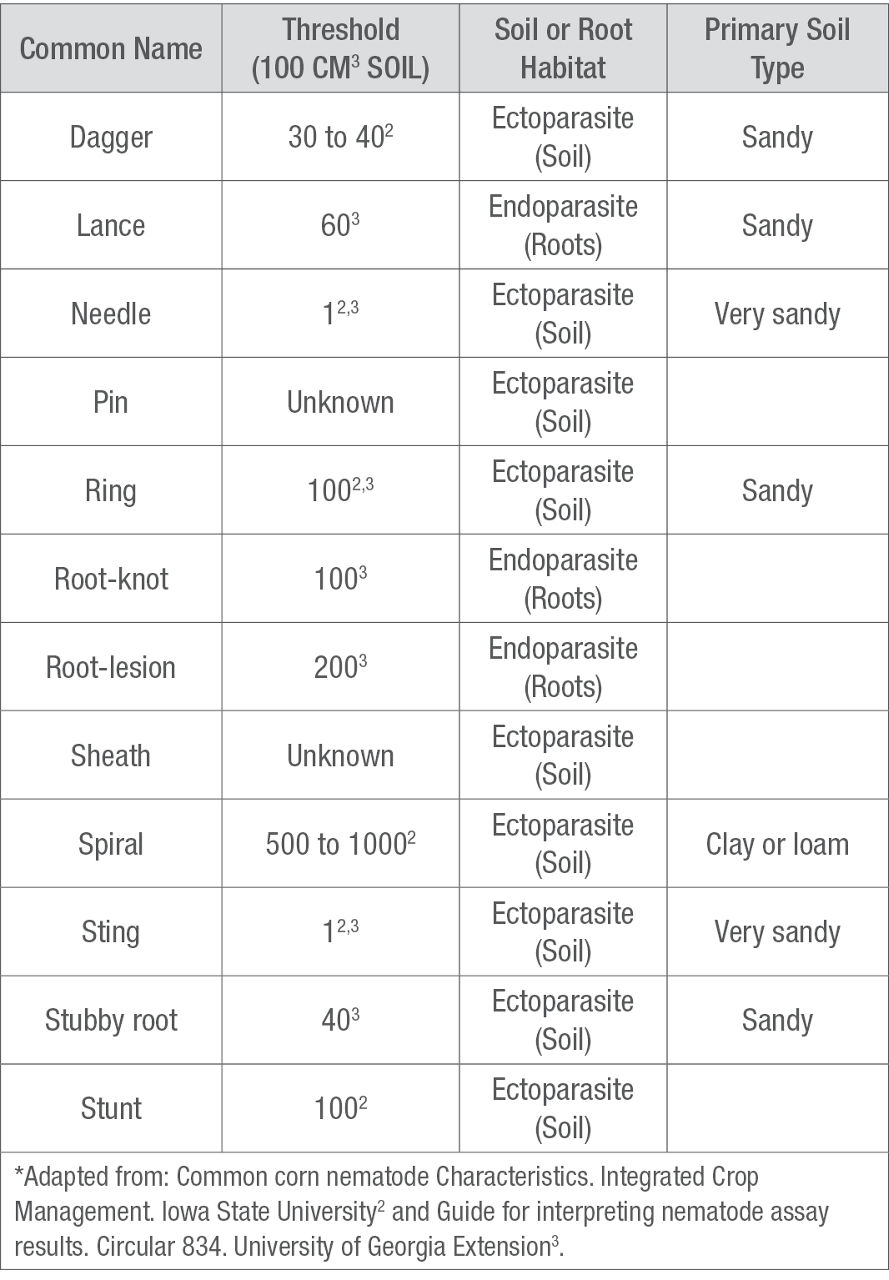How are Nematodes Impacting My Corn Crop in Season?
July 21, 2023
Summary
- Corn nematodes can reduce corn yield potential without visible symptoms.
- Nematodes can feed on the surface of the roots (ectoparasite) or within the roots (endoparasite) depending up on the species.
- Soil and root samples are required to determine nematode presence as well as species identification.
Introduction
Estimating yield loss due to nematode infestations can be difficult. Though yields may have been excellent, top-end yield potential may have been reduced because nematode feeding restricted nutrient uptake that could have increased yield potential. In 2022, the estimated losses to nematodes in the United States and Ontario, Canada were 54.2 million bushels.1 Individual nematode species vary regarding their damage potential. As an example, needle and sting nematodes can cause extreme damage when there is only one nematode per 100 cubic cm (cm3) of soil. Table 1 shows damage thresholds for different nematode species. It is important to understand that these are damage thresholds only and are NOT calibrated on a response to a nematode control product.
Table 1. Corn Nematodes, Estimated Thresholds, Habitat, and Primary Soil Type*

Corn growing under very good to excellent environmental conditions can be plagued with nematode feeding; however, symptoms may not be apparent, which sets the stage for hidden yield loss. Below is the complied list of above and below-ground symptoms caused by nematodes that can be confused with other agronomic factors (disease, fertility, insect, or herbicide injury).4
Above-ground Signs4
- Thin stands
- Stunted plants
- Uneven plant height
- Uneven tasseling
- Leaf yellowing
- Small ears and kernels
Below-ground Signs4
- Swollen roots
- Black or dark brown dead spots on roots (necrotic lesions)
- Limited fine roots and branches (Figure 1)

Root and soil sampling is the only way to determine the presence of damaging nematode populations in a field. Soil and root samples are required because some nematodes live within the roots (endoparasites) and others live only in the soil and feed externally on the roots (ectoparasites).
Field history and soil type play a huge role when soil sampling for nematodes. If a field has a known nematode history, then sampling timing can be dictated by the previously identified species. However, because of cooler soil temperatures, early-season sampling is generally recommended because nematodes are more likely to be closer to the surface.
If the field is at least 80% sand, sampling should be conducted prior to the V6 growth stage (6 leaves with exposed collars) because sting and needle nematodes can go several feet deep when the temperature in sandy soil increases. Regardless of soil type, if sampling is completed early in the season (by V6), 4 to 6 plants should be dug with roots intact. Collected samples should be representative of 40 acres or less. However, if nematodes are suspected in identifiable problem areas, soil samples should be collected from the problem and the non-problem area for comparison.
Sampling Procedures for Sandy Fields5
- Sample the perimeter of large, suspected areas instead of the center.
- The root zone should be probed 6 to 8 inches deep at an angle.
- About 20 soil core samples should be collected and mixed to get at least a two-cup sample.
- Double bag soil and plants separately in sealable zipper-top plastic bags.
- Samples should be handled gently to help avoid damaging nematodes.
- Refrigerate samples until shipping.
- Pack samples in a leak-proof container with soft packing material.
- Complete a submission form for the respective diagnostic laboratory.
- Samples should be shipped early in the week.
- Nematodes must be alive for proper analysis.
Sampling Procedures for Non-Sandy Soil Type Fields5
- If sampling is completed by V6 growth stage, 4 to 6 plants should be collected by digging the roots carefully.
- If sampling after V6, no additional roots are necessary providing soil cores are collected from the root zone.
- Collected samples should be representative of 40 acres or less. If nematodes are suspected in identifiable problem areas, soil samples should be collected from the problem and the non-problem area for comparison.
Nematode Management
There are two management strategies for damaging nematode populations: 1) crop rotation with non-host crops and 2) using available soil-applied nematicides to keep the population under check. There are no rescue treatments available. One yield-protection estimate for the use of a nematicide when damaging populations of root-knot, stubby-root, and sting nematodes are present is 10 to 40 bu/acre or more.6
Sources:
1Mueller, D. Wise, K. and Sisson, A. 2023. Corn disease loss estimates from the United States and Ontario, Canada – 2022. Crop Protection Network. https://cropprotectionnetwork.org/publications/corn-disease-loss-estimates-from-the-united-states-and-ontario-canada-2022
2Tylka, G. 2009. Common corn nematode Characteristics. Integrated Crop Management. Iowa State University. https://crops.extension.iastate.edu/cropnews/2009/08/common-corn-nematode-characteristics
3Jagdale, G. and Brewer, C.L. 2013. Guide for interpreting nematode assay results. Circular 834. University of Georgia Extension. https://extension.uga.edu/publications/detail.html?number=C834
4Tylka, G. 2007. Nematodes in corn production: A growing problem? Integrated Crop Management.
(IC-498) (1) Iowa State University. https://crops.extension.iastate.edu/encyclopedia/nematodes-corn-production-growing-problem
5Jackson-Ziems, T. 2015. Corn nematode sampling. CROPWATCH. University of Nebraska-Lincoln. https://cropwatch.unl.edu/corn-nematode-sampling
6Lee, R.D. (editor), Noland, R., Harris, G., Porter, W., Prostko, E., Buntin, D., Kemerait, B., Sumner, P., Toews, M., Rabinowitz, A., and Smith, A. 2019. A guide to corn production in Georgia. Corn disease and nematode management update for 2019. Pg. 100. Georgia Agricultural Commodity Commission for Corn. University of Georgia Extension. https://grains.caes.uga.edu/content/dam/caes-subsite/grains/docs/corn/2019-Corn-Production-Guide.pdf
Additional Source:
Tylka, G. 2009. Quick facts about corn nematodes. Integrated Crop Management. https://crops.extension.iastate.edu/cropnews/2009/04/quick-facts-about-corn-nematodes
Web sites verified 5/17/23 1211_131401